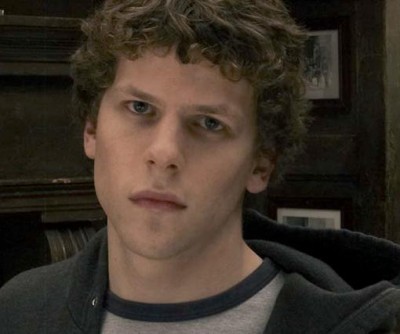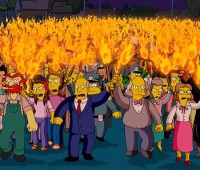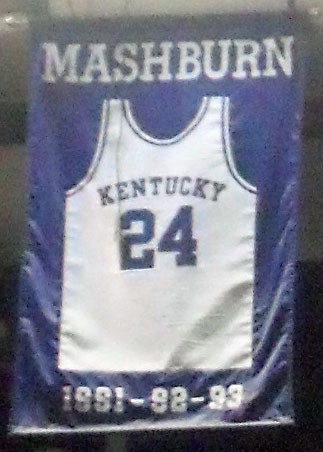Era Of Cheap Booze Ends In Britain
British binge drinkers, also known as “Britons,” had best hurry to stock up on cut-rate alcohol, as the government plans to outlaw the sale of inexpensive spirits today. You have our sympathies.
Will Scientists Cloning A Wooly Mammoth Be Trampled To Death Or Gored To Death?
Scientists in Japan are planning to resurrect the long-extinct wooly mammoth by cloning a cell taken from a carcass preserved in ice for 4,500 years in Siberia, and implanting it in the uterus of a female elephant. Should take about five years, they say.
Of course, there are serious questions. As one of the scientists, Akira Iritani of Kyoto University says, “If a cloned embryo can be created, we need to discuss, before transplanting it into the womb, how to breed (the mammoth) and whether to display it to the public.”
These are the wrong questions, I think. (Answers: As fast and prolifically as possible. And, Only once the special “Ice Age” theme park is built and also stocked with giant sloths and saber-toothed tigers.) Rather, I think the scientists should be concerned with the matter of exactly how will nature point out the folly of their extreme hubris this time.
Will they be flattened by a stampede of mammoths, once some long-dormant genetic memory is triggered in the reawakened beasts’ collective consciousness, and they realize that our ancestors hunted them to death and drew unflattering pictures of them on cave walls?
Or will it be goring?
Or will some invisible vapors escape the mammoth cells during the cloning process that, once breathed in, cause the scientists’ facial features to flatten and broaden into the famously hideous (and, apparently, genetically advantageless) visage of the neanderthal?
Or maybe even something worse?
Wear Boots Or Cry
Got boots? Put ’em on. I was once like you, with your dry, comfortable feet. Now I must navigate the day suffering through the scourge of squishy socks. I implore you, do not go down the same road (particularly if that road is 3rd Avenue around 18th Street, which, holy fuck, so much slush and ice). An umbrella would be helpful, but is not strictly necessary. But boots — sweet, sock-protecting boots — they will do you right. Also, if I’m slightly more grumpy than usual today, blame my damp, miserable feet. Okay, you’ve been warned.
'The Social Network' Is a Pack of Lies That Conveys Nothing About Our Time
by Richard Rushfield

Picture, if you will, the opening scenes of next year’s blockbuster, The Quagmire — a dramatic account of America’s descent into the war in Vietnam.
The film opens on young Lt. Lyndon Johnson of the U.S. army. He is stationed in Tokyo in the 1950’s. As the opening credits roll, he is sulking away from the base’s fancy officers’ club, his application for membership having been rejected. He realizes that try as he might, with his poor Texas upbringing, he will never be one of them. Stung, he ventures out into the field, across the Asian continent, turning over those stones that the well-to-do ne’er-do-wells back at the club couldn’t be bothered with. While travelling through Indochina, he sees up close the resistance to French rule and, in it, sees opportunity for a young soldier! Meanwhile, while passing through a village, he falls in love with a Vietnamese girl, who ultimately abandons him, because his poor Texas upbringing means that, try as he might, he will never be one of her people.
Ten years later, now President of the United States, Johnson signs an order sending half a million troops into Vietnam. He stares at the map of the land he is about to destroy…. We cut to the map, and then a misty shot of the village where long ago, he found love, and love was denied him….
Yeah. If audiences were shown the above tale of Vietnam, they would laugh it off the screen.
No matter how it “captured the spirit of the age” and dealt with important issues about America’s changing role in the world, those few little imagined pieces of history would remove it from serious discussion.
And yet? A film that takes liberties just as brazen and ludicrous with real life figures, a film that inserts similarly imaginary motivations into real life events, is being celebrated as a gripping drama and lauded by critics across America. It has won the Golden Globe for “Best Motion Picture: Drama” and is currently easily the front-runner for the Academy Award for Best Picture of 2010.
Yes, The Social Network is, no doubt, a finely crafted work. The acting is impeccable, the dialogue is zippy and zings along. As writer Aaron Sorkin himself pointed out in his bizarre speech last night, David Fincher made a story about computer nerds typing as entertaining as such a subject matter could possibly bear. But that’s not all he said.
In speech, Sorkin quotes scripted line from a fictional girlfriend, from an invented scene, then assures real Zuck: “She was wrong.” #metaMon Jan 17 20:15:51 via Echofon
nancy miller
nmillions
That Sorkin thanked his researcher in his speech was audacious, at best. Any film that treats history as flippantly as The Social Network does deserves to be taken as seriously as the new Yogi Bear adaptation.
The film’s misstatements have been well documented. The jilted love affair that drives Mark Zuckerberg to create Facebook is invented. The resentment against the Harvard elite clubs that drives him to create an alternate society is invented. The claims of others involved in the creation of Facebook are given vastly too much credence in the film. Zuckerberg is portrayed as an angry, vengeful sociopath, which by most accounts and all appearances, he is not.
But other than that, it says a lot of fascinating things about the era.
A dramatic work need not be faithful to every fact of history. We do not expect dramatic films to be moment-for-moment, not-a-hair-touched recreations of history. Even documentaries are forced to exercise some altering power in deciding what to leave in and what to cut.
But what we do expect, and regarding which we should not compromise, is that when a film purports to be a telling of actual events and the lives of real-life people, it gets the basic facts of those events and people right. Or at the very least tries! A biopic about Marie Curie and the discovery of radium, if it purports to tell the actual story, will not show the great scientist dressing in bearskin rugs to get in touch with her atomic nature and taking hot air balloon rides up the Amazon in search of a legendary molecule, unless it is clearly indicated that this is a fantasia of Marie Curie, not meant to be a realistic telling of actual events. (See: I’m Not There.)
The Social Network offers no such disclaimers. In a narrative punctuated by legal deposition, it strives for hyper-realism, suggesting strongly that these events did happen as they are being shown. In doing so, it far exceeds the limits of any commonly understood dramatic license.
We do not even regularly demand of dramatic recreations that every line of dialogue was actually spoken as portrayed. We can be tolerant of entire scenes and sequences being invented. But we only allow the filmmakers that leeway so long as we can trust that the scenes, the sequences, the characters, the dialogue created are in order to help dramaticize points that are in themselves true.
What Aaron Sorkin has done in the screenplay of The Social Network is to say, essentially, if I’m allowed to invent the dialogue, I should be allowed to invent the rest of the facts as well. Because, the screenplay’s liberties suggest, the facts of Facebook’s invention are not important in themselves. They are only relevant so far as they serve larger points Sorkin wants to make about the times in which we live. (Apparently, according to Sorkin, who despises the Internet and does not much use it, virtual identity has replaced actual identity. Oh dear!)
His project not only oversteps its bounds, but is fundamentally dishonest about its nature. The Social Network is not the story of Mike Zipperberg, creator of Smilepages. It is the story of the making of the most-visited website in the United States! Whose creator is himself the most famous entrepreneur our time! By telling us the story of Mark Zuckerberg and Facebook, the film asks the viewer to do half its work. You are to bring into the theater all that you know about Facebook and all you may have heard about Mark Zuckerberg. This film functions essentially like an “origins of the superheroes” comic book, showing you how the pieces fell into place to create this entity that you know well.
And if that is the mission of your script, you are obliged to make some attempt to get the very basics right — not to just walk away from them in the interest of making bigger, more imaginary points about the era.
Another current release shows just one of the many ways in which nonfiction can be handled. In All Good Things, the authors create a drama that is, as they indicate, merely inspired by events — in this case, the well-known disappearance of the wife of Manhattan real estate heir. Wishing a bit of latitude to dramatically explore the characters as they see them, the screenwriters changed the names of the protagonists from the real life people, taking it upon themselves to create characters and the world they inhabit. That is fine! Specifying this is a fictional world, no one expects them to stay absolutely true to the real facts, and no one takes the fictional version as a reflection on the literal truth of the case. Also no one gets sued.
In Richard Roeper’s year in review, he called The Social Network “the definitive look at the way our world has been changed forever by a site that turns everyone into the star of their own personal movie.” That a movie that invents the basic facts of its own tale can be considered “the definitive look at the way our world has been changed forever,” by no less than one of our most esteemed critics: this is a far more defining statement about our times than anything Aaron Sorkin has ever written.
Richard Rushfield is the preeminent American Idol scholar of our time, and author of the forthcoming Hyperion book American Idol: The Last Empire. He is also the author of ;Don’t Follow Me, I’m Lost: A Memoir of Hampshire College in the Twilight of the 80s.
After Tucson: 15 Pictures From Glock's Official Facebook Page
by Abe Sauer















Abe Sauer would like to point out that Sig Sauer’s Facebook gallery is no better. He can be emailed at abesauer [at] gmail.com.
The Coming Battle Between Goats And Monkeys
“[T]he days of the monkey in advertising may be numbered. And the likely successor to the funny-animal throne may not be a puppy or a LOLcat or a LOLrus, but the humble goat. The goat is not only funny — they talk, spit, faint — the goat is also a practical and cheap animal.”
Do Extended Unemployment Benefits Increase Unemployment? No.

Goldman Sachs released a report today Wednesday for its clients about unemployment, and finds that extension of unemployment benefits in a recession does not actually make workers lazy and unwilling to work.
Some commentators have argued that extended unemployment insurance (UI) benefits are the key reason for high unemployment in the United States. Using data from 20 OECD countries we present evidence to the contrary. Our results suggest that only ½ percentage point of the current 9.4% jobless rate can be explained by the extension of UI benefits. Moreover, our calculations suggest that this effect will fade when the extended benefits eventually expire. These estimates — broadly in line with a recent study by the San Francisco Fed — reinforce our view that the overwhelming share of unemployment is cyclical rather than structural.
Emphasis ours.
To the math!
We find that a 10 point increase in the replacement rate — broadly similar to what we saw during the Great Recession in the United States — is associated with a 0.2pt increase in the unemployment rate in the same year. Given the persistence in unemployment, the effect ultimately grows to just above 1 percentage point if the extension of the benefits is permanent (calculated as 0.2 divided by (1–0.83)). These estimates suggest that the unemployment rate is currently ½ percentage point higher due to the extension of the UI benefits than it otherwise would be.
So if you hear a politician saying this, please take away his job, because he’s too misinformed to govern.
The Saddest Day Of The Year
Treat with skepticism any claims you see suggesting that this is the most depressing day of the year. The science is flawed and many of the resulting explanations — including, it seems, the actual date in question — are inaccurate. In fact, after a lengthy investigation conducted by me, the saddest day of the year turns out to be “all of them.”
The Poetics of Mashburn

The mid-twentieth century French philosopher Gaston Bachelard is a favorite of my father’s. I recall vividly books by or on Bachelard strewn about our split-level ranch for a few of the mid-80s years Dad was index-finger-only typing out his dissertation on our silver Texas Instruments machine — the result a big, fat, impenetrable (to me, at least) treatise on the Frenchman’s philosophy and its relationship to higher education.
While the content of the Bachelard books — hell, even the descriptions on the outside covers — was lost on me (due to a typical American kid’s short attention span and/or disinterest in phenomenology at the age of 14), I was always picking them up and looking them over. As objects, they were of special, unknowable importance to my father — the things that occupied so much of his non-fatherly time back then. Even back then, one stood out to me even for the simple beauty of its title: The Poetics of Space.
The Poetics of Space is a philosophical rumination on architecture and the creation, manipulation and use of individual space. It’s one of those philosophy books only truly dedicated students get through, full of phrases that you have to read about 10 times before they make any sense, and often even that may not suffice. Take for example, Chapter 1 (which is about as far as I ever got back then): “Through dreams, the various dwelling places in our lives co-penetrate and retain the treasures of former days.” I mean, I could get it but I didn’t really get it.
Years later I finally had occasion to actually read Bachelard’s 1958 work as part of research for a paper I sought to write. It was hard slogging for me — I am by nature a dreamer, but was never much of a philosophizer — but I muscled through. Thinking back now, no small part of it was that kind of soft competition with/reflection on one’s father that smart, ambitious sons of smart, ambitious fathers experience at a certain age. For me, it was also about being the son of an academic, a career choice I had the ambition but, it turned out, not the stomach for. Accordingly, the content of my paper was fine, maybe even interesting in parts, but predictably I couldn’t get my heart into it and never really adequately finished it, so it never went anywhere. Let the Generation X jokes ensue …
But if I was not philosophically inclined, I had connected with a central premise of the book and of Bachelard’s vision: that we are prone to focusing on superficial “images” we take of things and that it is those images that keep us from a deeper understanding of the persons, places or things themselves. Trapped and limited by these images, it is only through working past or around them that we can better know the objects of our examination. And in order to do this, we must stop contemplating them with a purpose — with a false objectivity — in mind and instead allow ourselves to be engulfed by what Bachelard terms reverie — a sort of daydream state in which we let our mind wander the contours of our subject, allowing our minds to wander with only a loose focus on the object as a guide. It’s something we all do, something the most daydreamy of us do to distraction pretty much all the time. But it’s also deceptively simple.
Being a dreamy type anyway, I fell in love with this idea. Lounging just beyond the fuzzy edges in order to better know is as beautiful as it is natural to me. Bachelard set out to explain reverie by consideration of the four basic elements, beginning with fire.
Me? I’m no philosopher. No, I’ll go with multi-dimensional small forwards. And one, in particular.
Largely forgotten to all but Kentucky basketball fans, onetime Wildcats forward Jamal Mashburn was in his heyday a transcendent and revolutionary player. He was also my first real basketball crush. Mashburn was the player who took Kentucky a giant leap forward in credibility as the first elite national recruit to buy into Rick Pitino’s sales pitch when the beleaguered program was laboring under massive sanctions. As such, the slightly doughy forward from the Bronx was anointed as the program savior.
Like most 18-year old kids, Mashburn was still undisciplined and raw. But he was also really, really good. Like, eventual national Player of the Year good. He proved to be uncommonly strong, mobile, hardworking and humble. He was, in short, a joy to watch grow under Pitino’s tutelage.
It was not so long ago that the idea of a basketball player over 6-foot-5 who was not only capable of but encouraged to shoot and actually make deep jump shots was a novelty. For most of basketball history, you were either an inside player or you were an outside player, and no coach in his right mind wanted his few coordinated big men drifting out to the perimeter or handling the ball in the open floor. There were exceptions to this rule. And the list reads like a who’s who of basketball royalty: Oscar Robertson, Larry Bird, Bernard King.
But those are guys who come along once a generation. Mashburn wasn’t necessarily legendary in that way. Instead, what was important about Mashburn is that he was in many ways just another really good player, but one whose skills were a rare hybrid of post play and perimeter touch. And in Pitino, Mashburn had a perfect coach for his game.
For the most part, the late ’80s and early ’90s were still the days of the old guard of coaches. Ever in pursuit of that career-capping season, those coaching legends were loathe to alter an approach that had brought them to the pinnacles of their profession. And as rules began to change, these coaches — guys like Bob Knight, Gene Keady and Denny Crum — begrudgingly adapted to the changes brought by a shorter shot clock and the new three-point line.
Given this climate, it’s easy to forget now just what an innovator Pitino was back then. His wasn’t a gimmick system like the run-and-gun Loyola Marymount style espoused by Paul Westhead, nor was it rigid in its execution. When Pitino had shorter, less athletic players, he understandably chucked it up from deep. Once he was able to recruit the kind of athletes that would come to define the program — Mashburn, Antoine Walker, Walter McCarty, Rod Rhodes — his schemes adapted, too. Sure, there were still lots of three-pointers, but they were more liberally mixed in with set plays and a more viable interior presence. And there was, of course, that ever-present defensive pressure.
But if Pitino was great for the versatile New York forward, that defensive pressure and its resultant offense made Mashburn perfect for the Pitino system, too. At 6’8” (6’10” with his early-90s fade), “The Monster Mash” was big enough to rebound and bang inside, but versatile enough and a good enough passer to run the break from the middle of the court if needed, a must in Pitino’s trapping press. The value of a player who can catch and score on the block and bury shots from behind the arc is hard to overstate — even harder for a system that by design needs to have rotating parts all across the floor.
Mashburn, and players like him, was at the forefront of a change in the culture of the college game. On the way down were grind-it-out half-court offensive schemes. In were flexible offenses that could fast break and get easy buckets off their defense and whose players could nearly all run and shoot. The 1980s was a big man’s era — Ewing, Sampson, Olajuwon, Ellison. In part because of the three-point line, the 90s saw the emergence of the mobile big man, the inside-outside combo forward and the elite shooting guard. To wit, from 1990–2000, the NCAA champion’s leading scorer was a center only one time, in 1993 when Eric Montross and UNC beat Michigan.
But as Bachelard posited, relying only on the image keeps us from truly knowing what we observe. Thus, descriptions of a player’s importance or viability don’t really capture any of the poetry of watching him play basketball. The grace and fluidity that Jamal Mashburn exhibited on the court was a sort of ballet — spin after spin in the post, a wicked crossover with no wasted moves, a hitch-less over-the-head shooting motion off the dribble or the catch. With a defender on his hip, Mashburn would spin one way, then reverse on his pivot foot the other way and head-fake before ducking under the rising defender or effortlessly shooting with his off-hand. And he could do the same maneuver in the other direction.
When he caught the ball as the trailer on the break, as he often did in Pitino’s press, Mashburn would cross-over his defender — usually a power forward unaccustomed to playing 25 feet out — enter the paint area and loft a running teardrop one-hander, all in one motion. Or, without hesitation, he would plant his right foot an inch or so behind the three-point line and step into a jump shot that was pure nearly 40% of the time.
Not possessing of truly outstanding leaping ability or a particularly long wingspan, Mashburn made the most of what he did have: uncommon agility, a boxer’s natural footwork and timing, quick hands and no fear.
Never was this package more fully displayed than in the Sweet 16 of the 1993 NCAA tournament against Wake Forest. Again, while most folks have understandably forgotten his performance, if they ever even saw it, no Kentucky fan over a certain age ever will. It is rare to get to witness a truly gifted basketball player playing his very best on a big stage. And Mashburn’s first-half performance against the Deamon Deacons and their own similarly built and skilled forward Rodney Rogers was among the greatest I have ever witnessed.
Using his whole arsenal on offense, Mashburn — with a little help from his teammates — humiliated Wake Forest, going up 20–4 and never taking the foot off the gas. Mashburn scored 23 first-half points on a perfect 5-for-5 from three-point range and never saw action in the final 10 minutes of the game. But, again, it wasn’t just the statistical evidence that made it memorable. It was more that it was as close to offensive basketball gets to art.
There was no doubt that Mashburn would go pro following his junior campaign. There was nothing left for him to prove at Kentucky, and Pitino was ready to fill his shoes with a number of elite prospects. That’s what coaches like Pitino do. Mashburn had all the skills he would need for the NBA already. He was among the new breed of multi-position players the NBA coveted. He was drafted fourth overall in 1993 , behind Chris Webber, the freakish Shawn Bradley and Anfernee Hardaway. Webber and Hardaway were also rare combinations of size and agility, and both would prove it in successful pro careers.
In part because of guys like Jamal Mashburn, today we take for granted that 6’8” players can and should hit threes. Those that cannot, those whose throwback interior skills makes them in-the-paint players, are often dubbed “tweeners” — as in between positions — and they mostly grade out as good college players who lack the athletic ability or size to make the jump to the professional ranks.
But even ardent college hoops enthusiasts too easily get suckered into grading out players’ abilities based on their future pro potential or physical attributes. There is a temptation to fall into the trap of seeing the college game as something of a minor league for the NBA, and its players in a constant audition. This does a disservice to the players and, more importantly, to the college game overall. Because what makes the college version of the game most intriguing is precisely its fuzzy edges, its imperfections, its beautiful flaws. In NCAA basketball, “tweeners” can be more valuable than a better future prospect, and at this level, it’s routine for guys who are too short, too fat, too slow, too whatever to dominate a better athletic specimen on both ends of the floor.
We do, like Bachelard intoned, get caught up on our perceptions, on our images, of what a player is or is not instead of reveling in the simple pursuit of just watching and appreciating him, not judging or grading at all. But it’s not easy to do. Especially if you watch a lot of teams and a lot of players. You naturally begin to pick and choose and compare. Styles invariably contrast.
For me — and I wager for most folks who view college basketball through its own prism and not simply as a subdivision of professional basketball — it’s important to stop grading and just watch, just enjoy, just let the game happen. We don’t do it enough. If you make the effort to let go, to fall into reverie while you watch, you’ll see how a guy like Gary McGhee at Pittsburgh, or Demetri McCamey of Illinois or Levoy Allen at Temple gets it done despite supposedly lacking the “it.” Stop listening to talking heads tell you a player’s value and start letting that value, that basketball gift, overcome you.
For me, there was one player whose style, abilities and bearing were such that falling into reverie was easy. Sure, in this case it was the best player for my favorite team. Maybe for you, it’s the same.
Or maybe instead it’s some gritty walk-on, or an undersized fifth-year senior or a gangly freshman who was lightly recruited or a coaching style or none of these. Whatever the story, next time you watch try and let the poetics of basketball help you better understand what you are seeing rather than letting what you already know define the game. It’s a beautiful, if unfamiliar, dream.
THREE TO WATCH THIS WEEK:
Syracuse at Pittsburgh: While the Big East may be annoyingly omnipresent, thanks in part to too many teams and too many East Coast media types, this one should be a doozy. It might not be gorgeous basketball, but it will definitely be intense. Monday at 7:30 pm, ESPN.
Mississippi State at Georgia: Mississippi State has been a train wreck all season long, with enigmatic big man Renardo Sidney and starting point guard Dee Bost missing long stretches of time and looking spotty once back. Finally whole, the Bulldogs (in maroon) can still be the class of the SEC West (which isn’t saying much). Whether MSU is good enough to still make a run at the NCAA tournament may well depend on its ability to win games against better-regarded Eastern Division teams like Georgia, whose best three players are good enough to keep the Bulldogs (in red) on the cusp of the top 25 the rest of the season. Saturday at 4 pm, ESPN Full Court/ESPN3.com.
Indiana State at Wichita State: Actually locating this one on your TV might be tough, but if you can find it, you’ll get to see two of the Missouri Valley Conference leaders go at it. Both squads are cut from the same cloth — heavy on upperclassmen and well-balanced on offense. This one might not decide the league yet, but it’s mid-major, Midwest hoops at its late-January best. Saturday at 8:05, Satellite TV (Kansas 22).
Originally from Kentucky, JL Weill now writes from Washington, DC. His take on politics, culture and sports can be found at The New Deterrence and on Twitter.
